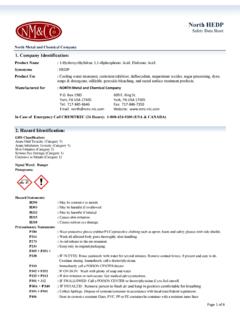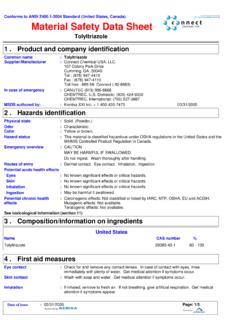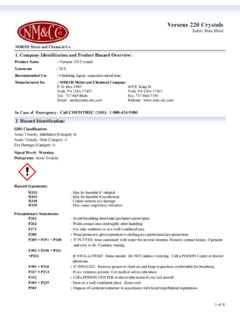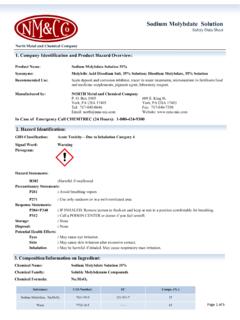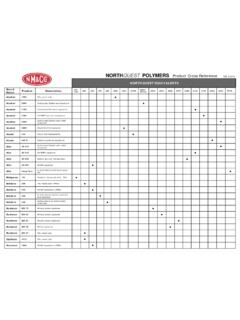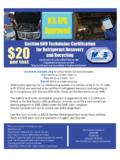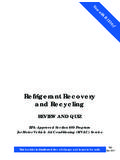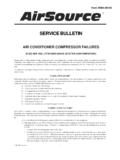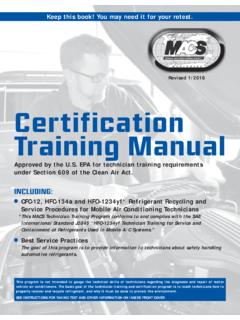Transcription of Material Safety Data Sheet - North Industrial Chemicals Inc
1 Material Safety data Sheet Distributed by: North Metal & Chemical Co. 609 E. King St. York, PA 17403 Date of Revision: 8/2008 Phone: (717) 845-8646; email: Sodium Tolyltriazole 50% Solution section 1 - Chemical Product and Company Identification Product/Chemical Name: Tolyltriazole sodium salt 50% solution, TTA 50%, sodium tolyltriazole 50% solution, TT50% Chemical Formula: C7H6N3Na CAS Number: 64665-57-2 Other Designations: Sodium 4-methyl-1H-benzotriazolide solution General Use: Anticorrosion additive Emergency Telephone: 1-800-424-9300 (Chemtrec) section 2 - Composition / Information on Ingredients Ingredient Name CAS Number EINECS/ELINCS % wt or % vol Tolyltriazole sodium salt 64665-57-2 265-004-9 < 50 Water 7732-18-5 < 50 Appearance/General Info: Yellow to amber Liquid.
2 INGREDIENT(s) OSHA PEL ACGIH TLV NIOSH REL IDLH Tolyltriazole sodium salt 50% solution None estab. None estab. None estab. None estab. section 3 - Hazards Identification HMISH F R 3 0 0 PPE Sec. 8 Emergency Overview Danger! Corrosive. May cause central nervous system effects. May cause cardiac disturbances. Causes eye and skin burns. May cause severe respiratory tract irritation with possible burns. May cause severe digestive tract irritation with possible burns. Potential Health Effects Target Organs: Primary Entry Routes: Eye, skin and ingestion Inhalation: Causes chemical burns to the respiratory tract. May cause central nervous system effects including vertigo, anxiety, depression, muscle in-coordination, and emotional instability.
3 Aspiration may lead to pulmonary edema. May cause cardiac abnormalities. May cause systemic effects. Eye: Causes eye burns. May cause chemical conjunctivitis and corneal damage. Skin: Causes skin burns. May cause skin rash (in milder cases), and cold and clammy skin with cyanosis or pale color. Ingestion: May cause severe and permanent damage to the digestive tract. Causes gastrointestinal tract burns. May cause perforation of the digestive tract. Carcinogenicity: IARC, NTP, ACGIH, and OSHA do not list Tolyltriazole sodium salt 50% solution as a carcinogen. Medical Conditions Aggravated by Long-Term Exposure: Chronic Effects: section 4 - First Aid Measures Eyes: Flush eyes with plenty of water for at least 15 minutes, occasionally lifting the upper and lower eyelids.
4 Get medical aid. Skin: Get medical aid. Flush skin with plenty of soap and water for at least 15 minutes while removing contaminated clothing and shoes. Wash clothing before reuse. Tolyltriazole sodium salt 50% solution Page 2 of 4 2 Ingestion: Do NOT induce vomiting. If victim is conscious and alert, give 2-4 cupfuls of milk or water. Never give anything by mouth to an unconscious person. Get medical aid immediately. Inhalation: Remove from exposure to fresh air immediately. If not breathing, give artificial respiration. If breathing is difficult, give oxygen. Get medical aid. Do NOT use mouth-to-mouth resuscitation. After first aid, get appropriate in-plant, paramedic, or community medical support. Note to Physicians: Treat symptomatically and supportively.
5 section 5 - Fire-Fighting Measures 0 3 0 NFPAF lash Point: >200 F Autoignition Temperature: >500 C LEL: N/A UEL: N/A Flammability Classification: Non-combustible Extinguishing Media: Use water spray to cool fire-exposed containers. Substance is noncombustible; use agent most appropriate to extinguish surrounding fire. Do NOT get water inside containers. Unusual Fire or Explosion Hazards: During a fire, irritating and highly toxic gases may be generated by thermal decomposition or combustion. Vapors may be heavier than air. They can spread along the ground and collect in low or confined areas. Contact with metals may evolve flammable hydrogen gas. Containers may explode when heated Hazardous Combustion Products: substance itself does not burn but may decompose upon heating to produce irritating, corrosive and/or toxic fumes.
6 Fire-Fighting Instructions: Do not release runoff from fire control methods to sewers or waterways. Fire-Fighting Equipment: Because fire may produce toxic thermal decomposition products, wear a self-contained breathing apparatus (SCBA) with a full face-piece operated in pressure-demand or positive-pressure mode. section 6 - Accidental Release Measures Spill /Leak Procedures: Clean up spills immediately, observing precautions in the Protective Equipment section . Provide ventilation. Small Spills: Absorb spill with inert Material , ( , dry sand or earth), then place into a chemical waste container. Large Spills Containment: For large spills, dike far ahead of liquid spill for later disposal. Do not release into sewers or waterways. Cleanup: Provide ventilation.
7 Regulatory Requirements: Follow applicable OSHA regulations (29 CFR ). section 7 - Handling and Storage Handling Precautions: Do not breathe vapor, mist, or gas. Do not get in eyes, on skin, or on clothing. Keep container tightly closed. Do not ingest or inhale. Use only in a chemical fume hood. Discard contaminated shoes. Storage Requirements: Store in a cool, dry place. Keep container closed when not in use. Store in a tightly closed container. Corrosives area. section 8 - Exposure Controls / Personal Protection Engineering Controls: Ventilation: Provide general or local exhaust ventilation systems to maintain airborne concentrations below OSHA PELs (Sec. 2). Local exhaust ventilation is preferred because it prevents contaminant dispersion into the work area by controlling it at its source.
8 Administrative Controls: Respiratory Protection: Seek professional advice prior to respirator selection and use. Follow OSHA respirator regulations (29 CFR ) and, if necessary, wear a MSHA/NIOSH-approved respirator. Select respirator based on its suitability to provide adequate worker protection for given working conditions, level of airborne contamination, and presence of sufficient oxygen. For emergency or non-routine operations (cleaning spills, reactor vessels, or storage tanks), wear an SCBA. Warning! Air-purifying respirators do not protect workers in oxygen-deficient atmospheres. If respirators are used, OSHA requires a written respiratory protection program that includes at least: medical certification, training, fit-testing, periodic environmental monitoring, maintenance, inspection, cleaning, and convenient, sanitary storage areas.
9 Protective Clothing/Equipment: Wear chemically protective gloves, boots, aprons, and gauntlets to prevent prolonged or repeated skin contact. Wear protective eyeglasses or chemical Safety goggles, per OSHA eye- and face-protection regulations (29 CFR ). Contact lenses are not eye protective devices. Appropriate eye protection must be worn instead of, or in conjunction with contact lenses. Safety Stations: Make emergency eyewash stations, Safety /quick-drench showers, and washing facilities available in work area. Contaminated Equipment: Separate contaminated work clothes from street clothes. Launder before reuse. Remove this Material from your shoes and clean personal protective equipment. Tolyltriazole sodium salt 50% solution Page 3 of 4 3 Comments: Never eat, drink, or smoke in work areas.
10 Practice good personal hygiene after using this Material , especially before eating, drinking, smoking, using the toilet, or applying cosmetics. section 9 - Physical and Chemical Properties Physical State: Yellow to brownish red liquid Appearance: Odor: mild odor Vapor Pressure: 25 mbar @ 20 C Vapor Density (Air=1): Formula Weight: Density @ 20 C: g/ml Specific Gravity (H2O=1, at 4 C): pH: (10% solution @ 25 C) Water Solubility: miscible Other Solubilities: easily soluble in Methanol or Acetone Boiling Point: >108 C (227 F) Freezing/Melting Point: 14 - 23 F Viscosity: Refractive Index: Surface Tension: % Volatile: 50 % Evaporation Rate: < 1 (n-Butyl Acetate = 1) section 10 - Stability and Reactivity Stability.
